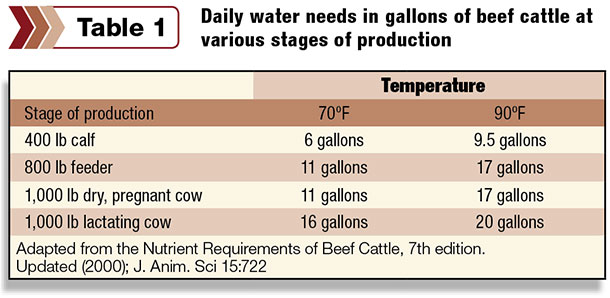Water quantity and animal requirements
Water is one of the five basic classes of nutrients required for all classes of beef cattle, and makes up about 98 percent of all molecules in the body. It is critical for a range of body functions, including growth, reproduction, lactation, digestion, temperature regulation and waste removal.
Daily animal water requirements are dependent on the stage of production, physical activity, type of diet, feed intake and the environment. You might be surprised that water requirements of cattle roughly double as the temperature increases from 50ºF to 95°F. In general, as the size of the animal increases, water requirements also increase.
The following table illustrates the daily water needs in gallons of beef cattle at various stages of production:

Water quality and sources
Waterer placement in pastures
Choosing the right spot for a watering system is a big decision that can impact animal grazing patterns. In intensive grazing systems (rotating among multiple paddocks), a central location that is shared among multiple paddocks, such as a fence line or lane, may help a water source serve multiple areas at once.
Match water tank size to the needs of your herd (i.e., the size of animals, how much supply is needed). Determine if pipes and lines are of adequate size to supply the needed amount in order to make sure consumption doesn’t outpace what is supplied.
Other sources
Cattle can have a significant impact on pond or stream banks and associated wildlife that are part of this ecosystem. When cattle have uncontrolled access to these areas, an increase in sediment and ammonia in the water is often observed. This creates a negative environment for aquatic species living in these areas and can also decrease cattle performance.
Water quality can be improved by reducing access to these areas. With higher cattle prices, now may be a time to consider investing in a watering system, or fencing to alter animal grazing patterns and decrease accessibility to these sources. Contact the Natural Resources Conservation Service for information on designs for restricted access points and ways to improve water use on your operation.
Conclusions
In summary, it is important to watch resources carefully during the summer months to make sure cattle have access to clean water. ![]()
Kim Mullenix, Ph.D., is an extension beef cattle systems specialist for Auburn University.








